i.
it’s been at least a decade—maybe two—since the data, the reports, the dire proclamations, the naming of the Anthropocene have declared a climate and nature emergency. and the march continues. daily some aspect of the media reports the latest in our inexorable march towards the sixth (or is it the seventh?) extinction, global climate catastrophe, increasingly dire (shrill, at this point, no?) predictions of collapse, destruction, perish. and yet, the academy continues to churn out data, reports, proclamations, new names to fearsomely encapsulate the human, more than human, earthly predicament of our time.
observing this perpetual data and reports machine, one wonders, “to what end?” or maybe, “when will it end?” (i mean, the endless stream of reportage, not it = humanity or earth or whichever ends first.) presumably, when we get our collective shit together and start to take substantial action to dismantle the systems and conventions that have led to the climate and nature emergency—colonialism, capitalism, consumerism, and patriarchy—and reassembling social, cultural, political, and economic constructs in some more equitable and just manner. imagining an end to colonialism, capitalism, consumerism, and patriarchy and shifts to new (better?) constructs requires sitting with discomfort, releasing assumptions and preconceived notions, and testing the limits of what is known or, better yet, giving up what we believe we know to examine and use other knowledges [1]. it is in these spaces that both artists and “scientists” [2] operate and it is in these commons that collaboration and conspiratorial work can achieve dynamic shifts in how humans exist as individuals and co-exist in community with others, with kin, with earth. Joan Retallack, certainly one of our most astute thinkers (and doers) of what it means to create meaningfully and purposefully, fully teases out this notion of artists and scientists working conspiratorially to magnify both our outcomes:
“Why pay attention, as [artists], to science or, scientists to [art]? Interestingly, both science and any instance of poesis (creating forms) may only be as meaningfully reliable as the combined effects of its ethos, logos, pathos.
In fact, each scientific discipline develops its own poetics if we understand poesis as transforming ideas and materials into forms. If the desired outcome is to share what counts as knowledge, meaning, the kind of searching that fuels curiosity and leads to the pleasures of wonder, then we must honor science with the astute precisions of [art], and [art] with those of science. The goal? To inspire and illuminate (human) forms of life among those of others with whom we are evolutionarily, ecologically, intimately related. Because it happens (as evolution has happened) that our human differentia endows us with critical responsibilities for the “fate of the earth,” that responsibility extends to the arts and sciences, where the beauty of the gravitas and humor begins in the ethos, logos, pathos of earnestly deployed curiosity: noticing, questioning, experimenting by creating procedures, wagering on what can’t be known unless it has been experienced in concert with the entire human sensorium.” [3] (emphasis my own).
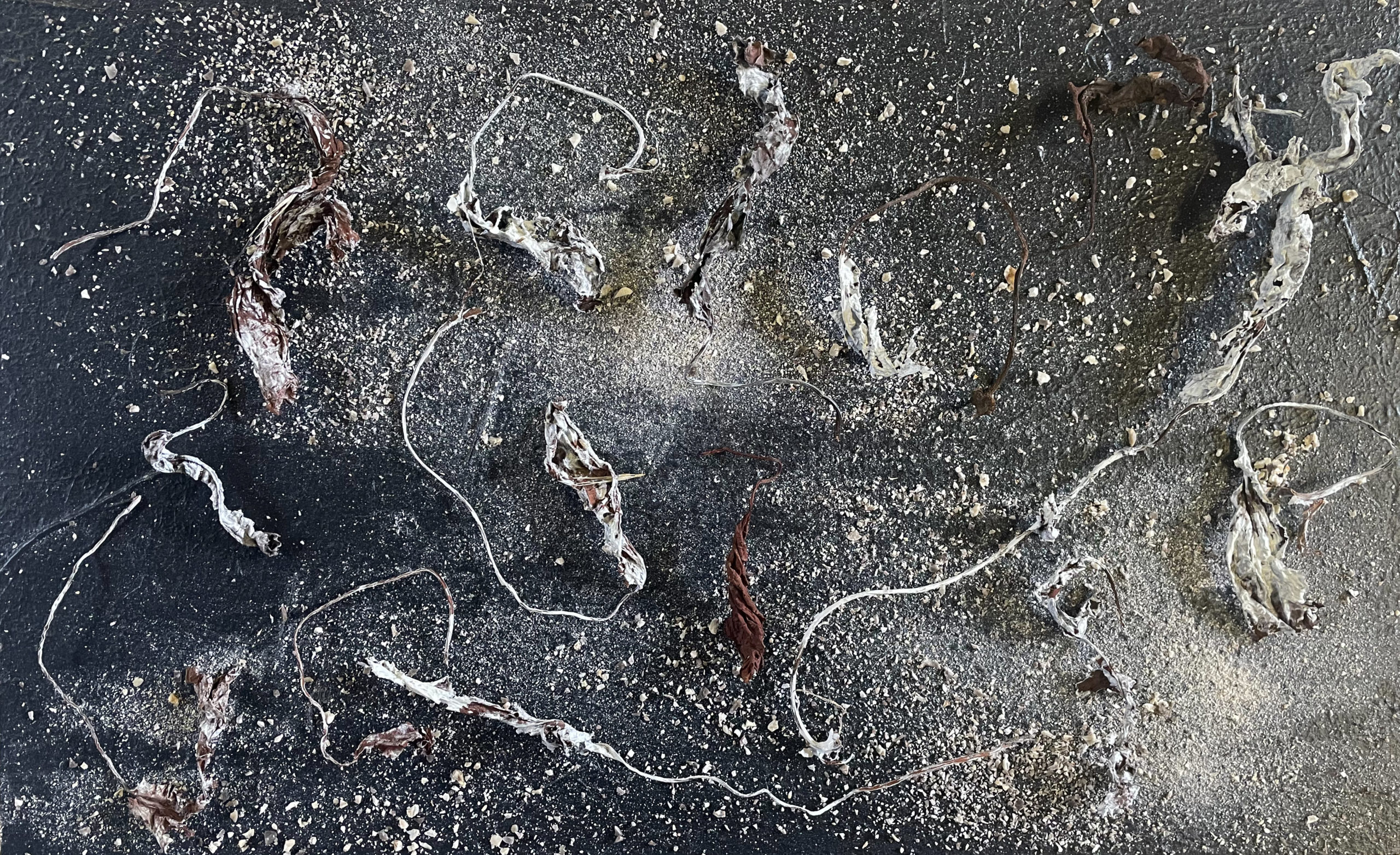
lithic dust, fallow flora. part 3. attunement to the geology and botany of geographies is central to my work.
this commonality of initiative and inertia for artists and “scientists” [4] to create with the combined effects of ethos, logos, pathos suggests that working in cross- and inter-disciplinary ways may be central to moving from the stasis of today’s green lipstick on the pigs (no offense to our Sus domesticus kin) of colonialism, capitalism, consumerism, and patriarchy towards a rework of systems and conventions that embrace and activate balance and equity, fairness and justice for all manner of life and existences.
ii.
the desert is a geography that has long intrigued, soothed, nourished, and inspired countless beings. i have returned to the Sonoran as a guest of Arizona State University’s Desert Humanities Initiative to convene and conspire about the work they do to “provide environmental experiences with the desert Southwest…through physical engagement and cultural framing” [5] and my work that relies on the material and energetic composition of desert geographies. time in the desert with Desert Humanities is provocative. the framing of landscape through intentional inter- and cross-disciplinary lenses opens up knowledge of and awareness to social, cultural, and ecological histories, presents, and futures that otherwise go un(der)-explored or un(der)-noticed. that ASU facilitates Desert Humanities through its College of Liberal Arts and Sciences means that work with and between traditional humanities fields (philosophy, history, cultural studies, languages, arts, etc.) and natural and social sciences (geology, anthropology, sociology, etc.) is interwoven. the diversity of subject, knowledge, approach, style, and content between the called-in academic disciplines has direct influence on the work and outcomes of Desert Humanities.
my artistic process is grounded in listening, seeing, and feeling into landscape/geography, each sense made more acute by periodically being guided into and through landscapes by wisdom and knowledge holders. over the past four years, my work with and in the desert has been informed by naturalists, scientists, spiritualists, and those who hold no title, but are connected to the desert through heritage and ancestral ties. my introduction to the work of Desert Humanities reveals a commitment to lore and learning that is complementary, amplifying, and additive to those experiences. for sure, there is a formality to Desert Humanities that is in contrast to the independent and individual—and frequently deeply spiritual—approaches of my previous experiences. yet, this institutional formality gives rise to the possibility of reach and impact that is necessary to activate towards a rework of the systems and conventions that are destroying humanity, our kin, and the earth we share. this is stated with full awareness that, as a component of western academic institutions, these kinds of programs have history as being founded on and perpetuating the systems and conventions that lay at the center of our climate and nature emergency (colonialism, capitalism, consumerism, and patriarchy). full recognition that we must continue diligence of examination and critique to ensure that institutions are doing better, but Desert Humanities and similarly-minded initiatives may be assisting repair, restitution, and reimagining by doing better than/more than tokenizing other knowledges and ways of being and doing. the collaborative work of Desert Humanities is provocative. it holds the promise of shared and pooled knowledge activating new interpretations and understandings; informing and guiding independent work to examine new paradigms; and generating output that has the possibility of tangible, resonant, and actionable impact.
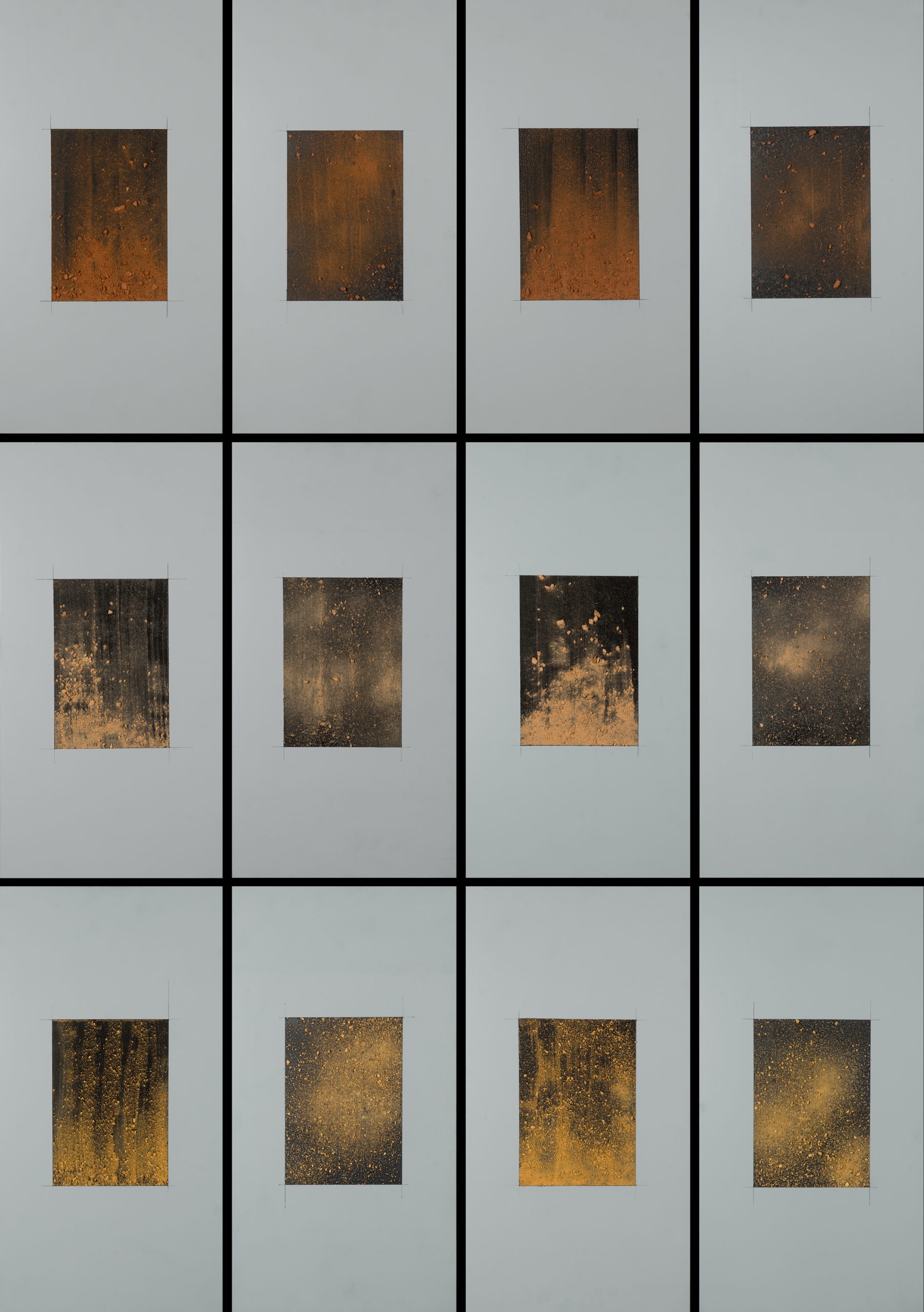
lithic dust. series 1. a collection of 12 panels using stone from 3 desert geographies (top row, Grand Staircase – Escalante; center row, Parashant; bottom row, Bears Ears) to create exposures on painted hardboard.
among its activities, Desert Humanities stages events in desert geographies to engage the public in different aspects of desert life, history, culture, and ecology. a recent event, “You Are Here: Way Finding and Emergency Preparedness” combined introductions to the cultural, social, and political history of maps with examination of how maps simultaneously inform and obscure the relationship between representations of space and experience in a place with instruction on orienting and navigating using a map, compass, and land-based cues. the result of this collaboration between geographer, phenomenologist, and backcountry rescue veteran was a revelatory perspective on what constitutes a map; what information maps contain versus what they omit and why are those choices are made.
iii.
these existential questions of map as storyteller of relationship, representation, and relevance accompany me into the Sonoran on a wilderness hike of the Superstition Mountains. they remain questions to ponder and examine as the images captured and collages created from the experience begin to gestate as ideation and inspiration for a series of developing works.
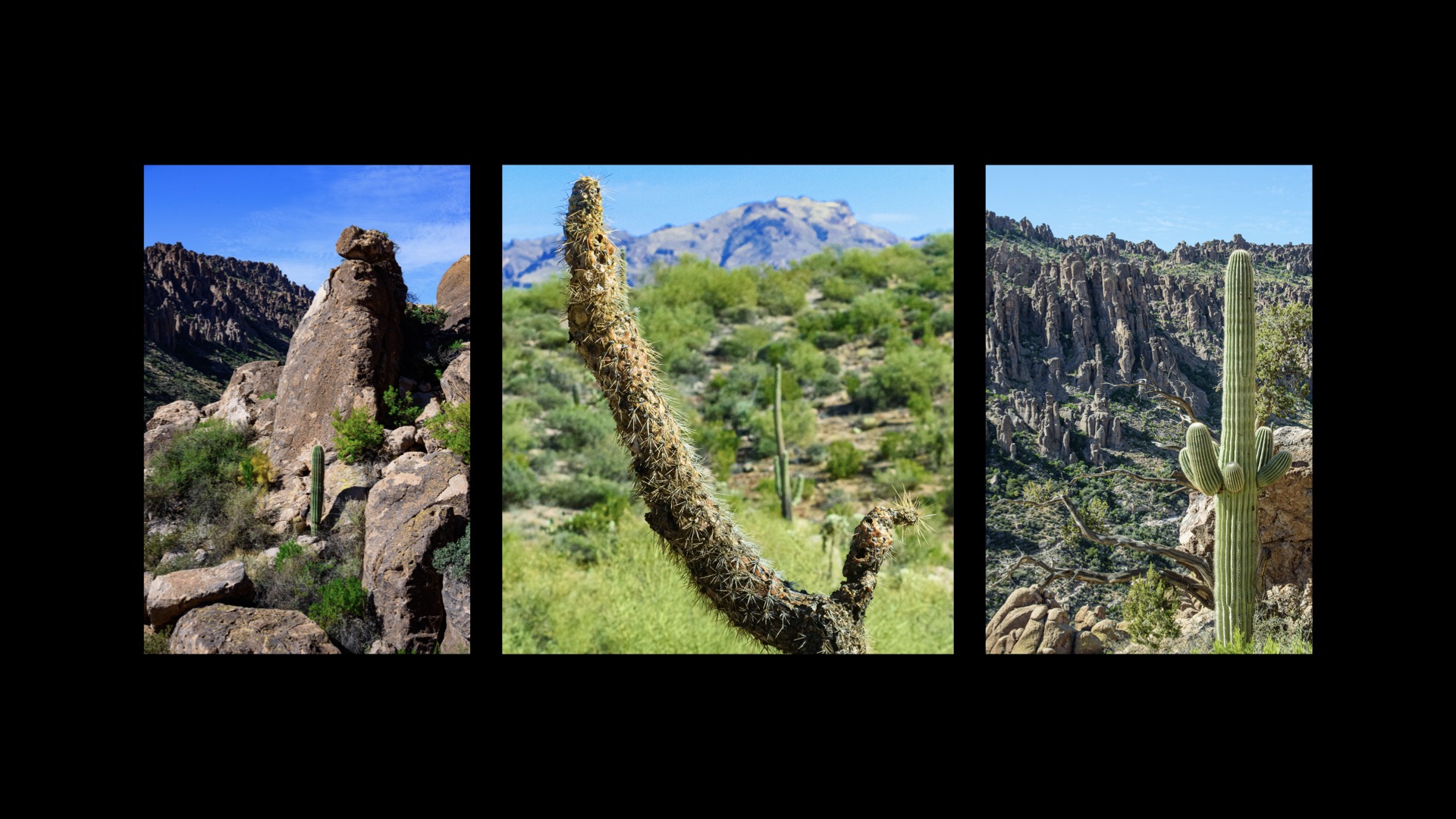
lush green pervades the Sonoran after a rain-filled monsoon season in 2022.
on the western edge of the suburban/wild interface where we begin our hike, the veritable lushness of the desert following much needed above average rainfall during the 2022 monsoon season is notable. [6] as we climb higher, the lushness of lower elevations begins to fade as the flora gets hardier and less dense. the scrub remains chromatically green and (i am told) that the cacti are multiplying and budding aggressively, yet the scars of past seasons’ dryness are evident. the complex beauty of flora-in-death juxtaposed against the desert palette is striking.
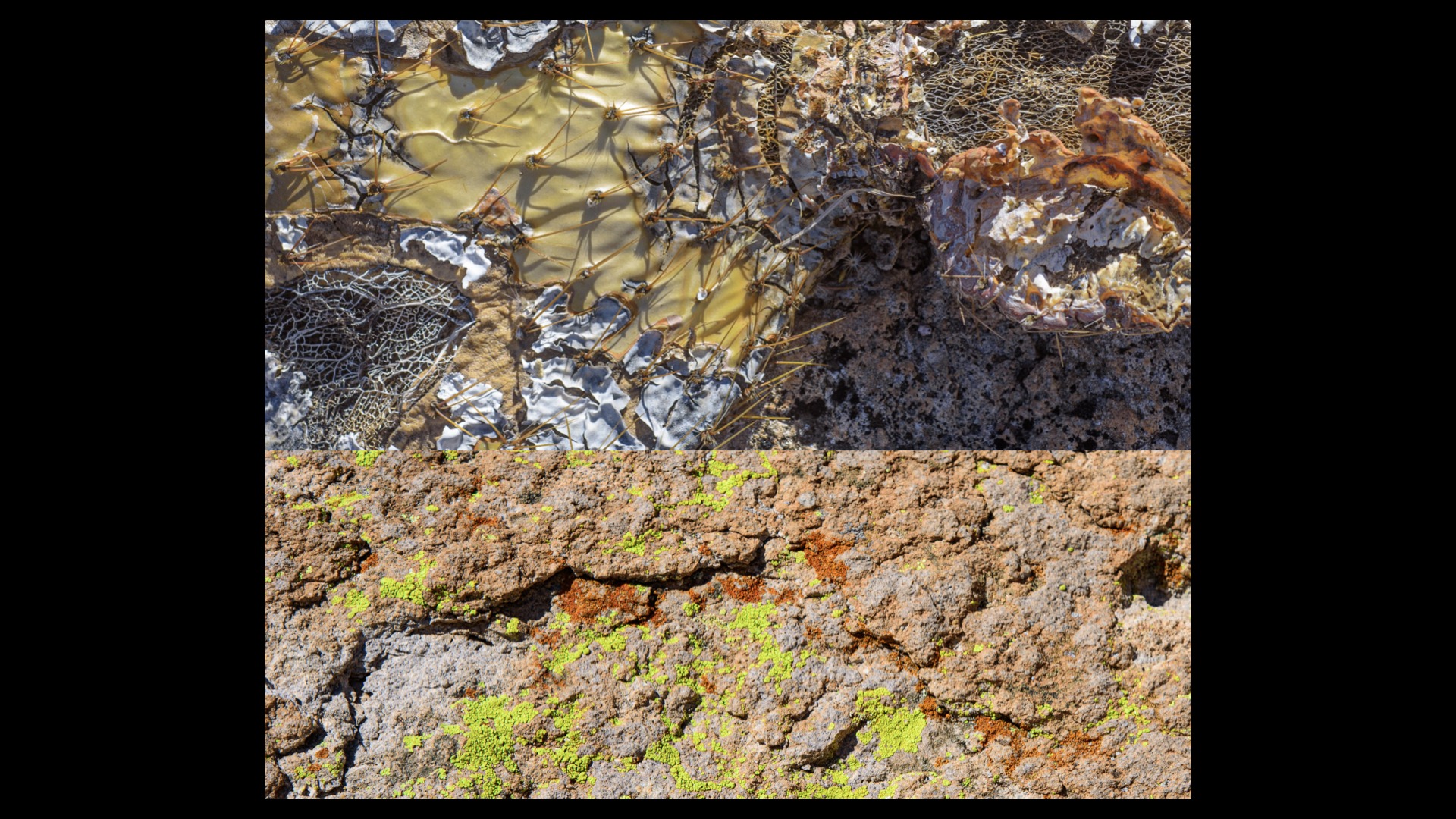
a species of Prickly Pear cactus (likely Opuntia chlorotica) in various states of decay. note the pale yellow and rust colors, mimicking the tones of the desert rock with rain-fed funguses growing on it. the nearly florescent green fungus recalls the vibrant green that the cactus would have once been.
we navigate our way through the backcountry using land cues and sometimes pulling out the topo map and compass. i recall the geographer’s probing considerations of how maps change over time: boundaries, place names, natural and manmade features, and even topography. mostly these changes are artificial, observed and expressed by the mapmaker and influenced by social, cultural, and political framings, but the results are evident changes in relationships of humans to each other, to the more-than-human, and to the Earth (and, in the case of astronomical maps, the Universe).
dwelling on the scars on the Saguaro (Carnegia gigantia) and the sinuous veining of the exposed vascular tissue of various species of Prickly Pear (Opuntia…) these marks take on characteristics of maps: both marking and be marked by pathways, topologies, notable outposts of each kin’s life and unique experience. and so it is for humans. maps can serve to guide, but also control our experience. they are indicators of human cultural and political dynamics (think gerrymandering, red-lining, creating borders where no physical borders exist, etc.). in way-finding, their usefulness poses a conundrum: we use maps to navigate our way across terrain using graphic representations to reflect the terrain back to us in an effort to have us make sense of the terrain we are navigating.
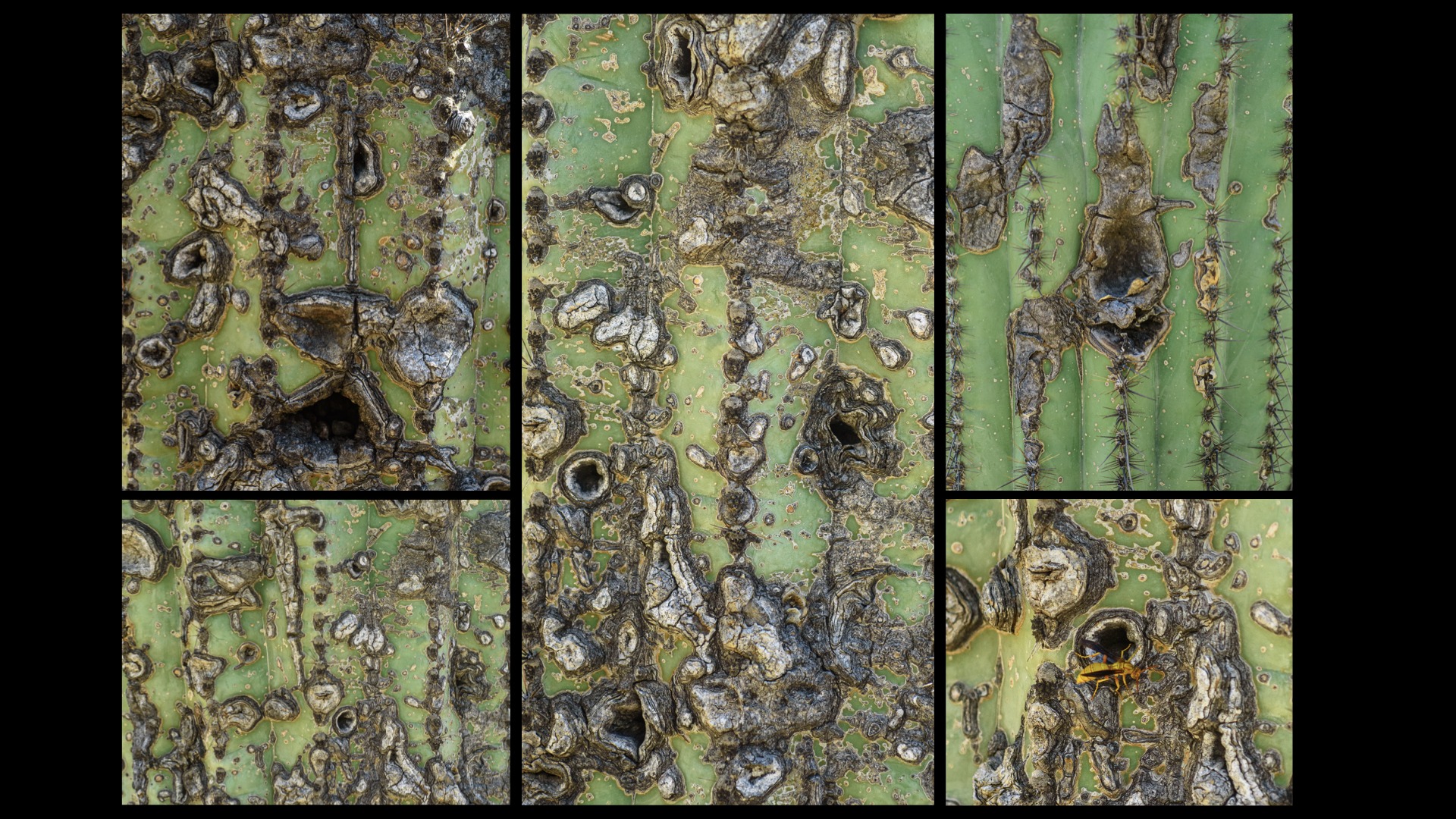
photo collage of scarring on Saguaro (Carnegia gigantia) cacti. the uplift and form of the scars are reminiscent of contour lines and shaded relief of topographical maps, yet are physical marks and expressions of the cactus’s ‘map of life’. the geometry and separation of the images is intentional, reflecting the artificial linear borders of much of the western states.
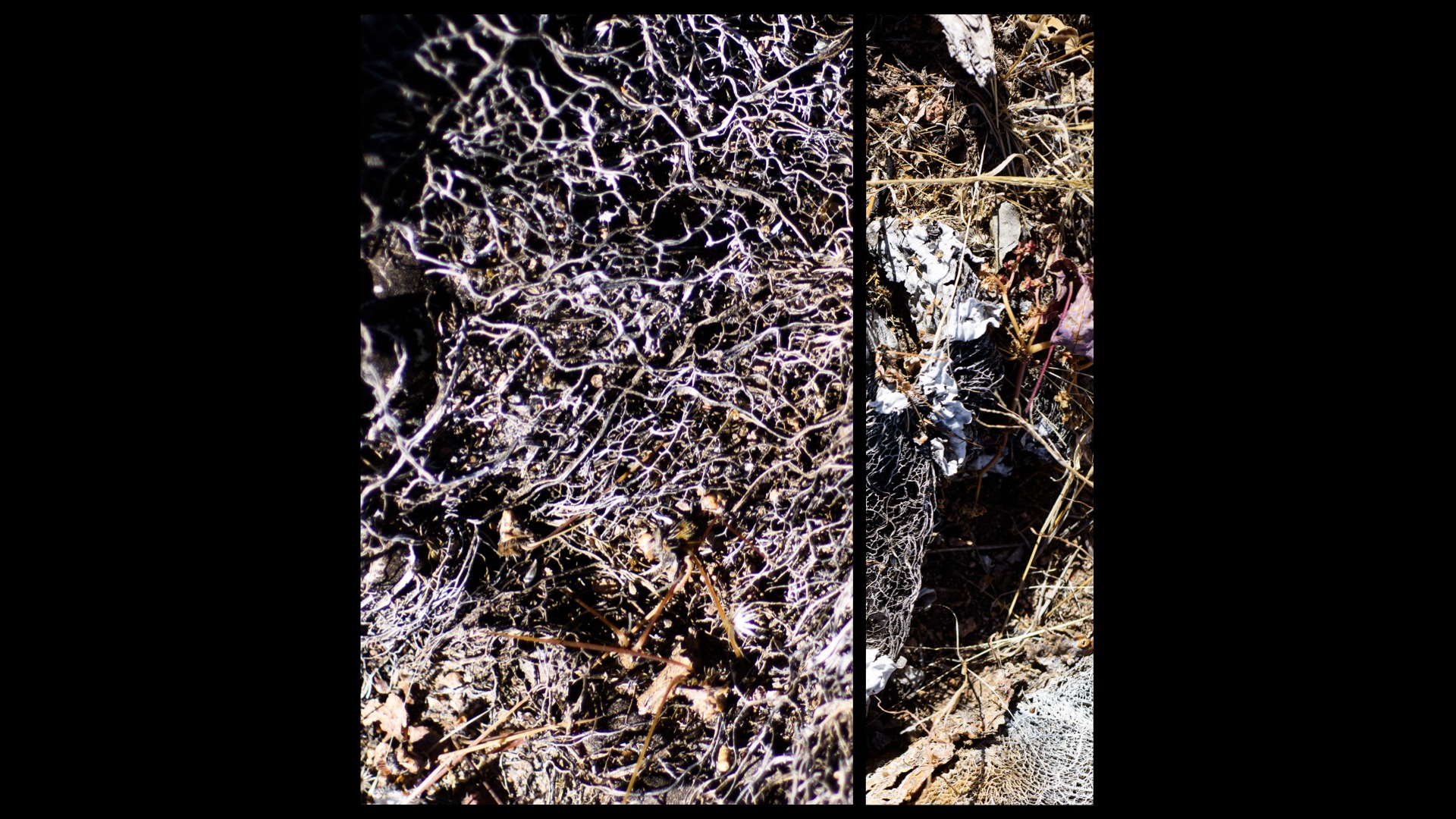
a collage study of veining of the vascular tissue of decayed cacti (likely species of Optunia).
iv.
my artistic intention is to compel the viewer to consider and mindfully explore our (human) place on Earth and in the Universe. the developing works borne from my experiences with Desert Humanities and this mid-winter touch into the Sonoran is to utilize maps as an artifact for framing discussion of where we find ourselves presently within a climate and nature emergency. we are bombarded by data, reports, literature—tools of communication that favor western, privileged, colonialized education and ways of thinking. all those words and numbers attest to the facts of destruction, loss, peril, but have had limited impact on humanity taking collective action to dismantle systems of extraction and harm and to reassemble social, cultural, political, and economic systems for equitable and just futures.
maps function as effective tools because of their inherent graphic expression. maps (and other graphic representations) can effectively—oftentimes beautifully—express (or sometimes dangerously distort), where to find our place, where to head towards, what is obstacle, and what is opportunity. we individually must find and be secure in our own place (internal. external?) before the journey begins. navigating the terrain of obstacle and opportunity in conjunction and collaboration with holders and practitioners of other knowledges reveals new possibilities, new potentials, new pathways to previously unimagined futures.
ed. note: gratitude to Arizona State University’s Dean of Humanities at The College of Liberal Arts and Science, Jeffrey Jerome Cohen and Professor and Director of Desert Humanities and Associate Director for Institute for Humanities Research, Ron Broglio for supporting my work. also, thank you to the coordinators and participants at Anticipation 2022, held at and in conjunction with ASU’s Global Futures Laboratory. your work is filled with purpose and hope and is endlessly inspiring.
christopher losa is an artist who lives and works on the edge of a redwood grove in a place presently called sonoma county, ca. he arrived at his artist’s calling after spending too many years in a career that, while filled with learning and experiences of a particular sort, did little to care for or lift up the humans, non-humans, and issues that he cares most about. he now works to hone his craft, continue learning, and contribute to amplifying the voice of the environment, of cultures, of ways of life struggling to survive under the weight of 8 billion people.
he can be reached at cl@coalesce.work or through his website www.coalesce.work.
[1] a nod to Vanessa Andreotti, her collective Gesturing Toward Decolonial Futures, and her summary of her work contained in Hospicing Modernity, Facing Humanity’s Wrongs and the Implications for Social Activism. North Atlantic Books, 2021.
[2] in quotes to express the usage as euphemism for all non-arts disciplines of the academy.
[3] Jan Baetens, “Experimental Writing and Beyond, An Interview with Joan Retallack,” https://www.place-plateforme.com/place3/baetens-retallack.html.
for a more complete reading of Retallack’s ideas about meaningful and purposeful creation (amongst other topics), see The Poetical Wager (Berkeley: University of California Press, 2003).
[4] see note 2.
[5] https://ihr.asu.edu/desert-humanities
[6] the hike began from a trailhead in Apache Junction, AZ where measured rainfall for the 2022 monsoon season was greater than normal. see Region: Central Arizona and Site: Phoenix at https://www.weather.gov/twc/Monsoon for statistics.
This article is part of the MAHB Arts Community’s More About the Arts and the Anthropocene. If you are an artist interested in sharing your thoughts and artwork as it relates to the topic, please send a message to Michele Guieu, Eco-Artist and MAHB Art Director: michele@mahbonline.org.
Thank you.

